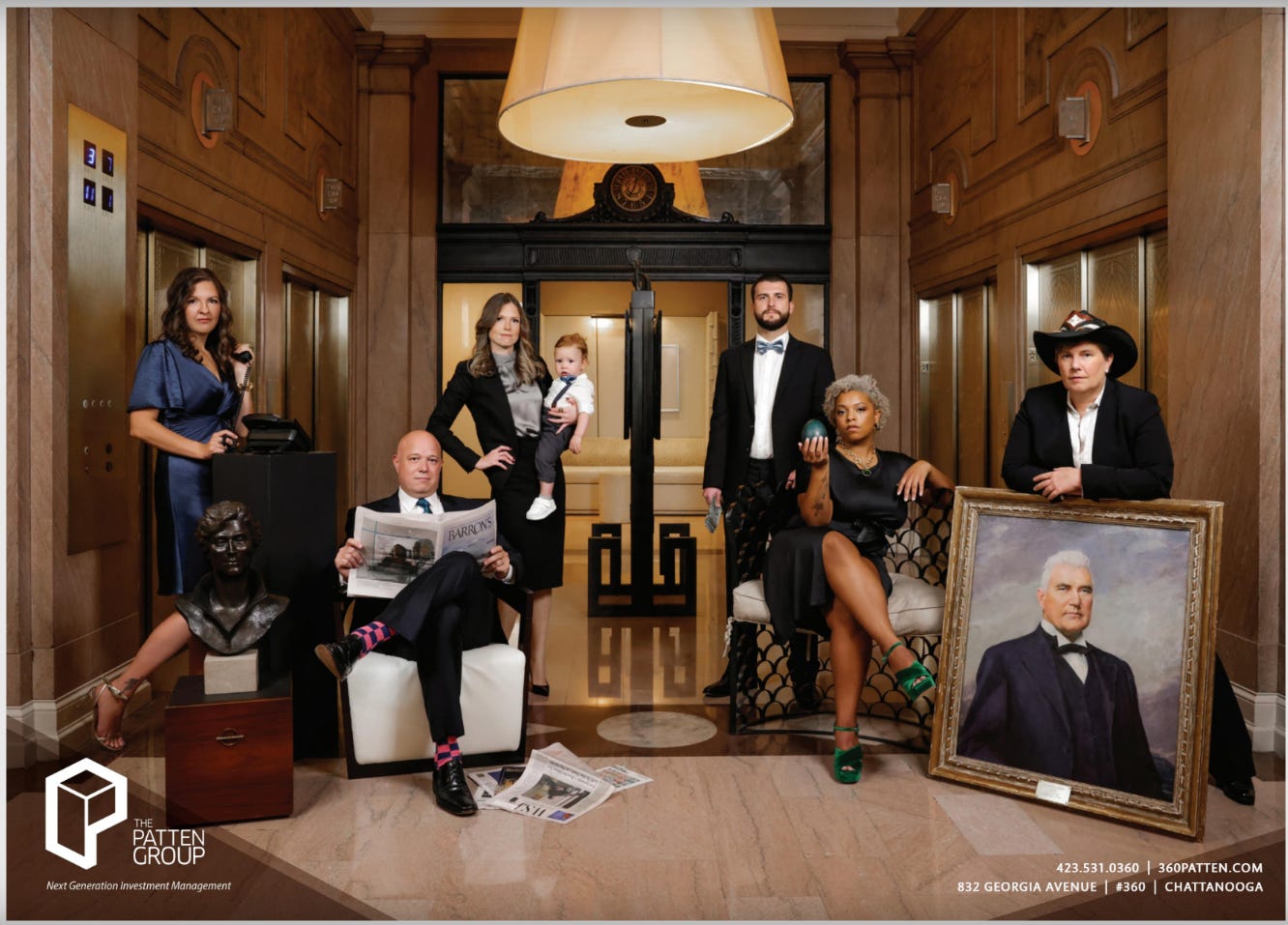How to Spend Your Money so Your Neighbors Know You’re Rich
Diving into the advertisements of a little magazine called The Scout Guide
I don’t talk about my professional life very much in this newsletter, but by day, I’m a marketer at a B2B media company. Serious time spent in any job gives you an eye for specific things related to that job that most people glance over. For example, after working at a tech startup in the storage industry, to my eternal displeasure, I can’t help but notice every storage facility I pass on the highway. My mother, trained in clothing production and design, can spot a bad hemline from across the room, and my wife, a florist, can’t walk past a bouquet of flowers without giving them a touch-up.
Marketers pay more attention to advertisements than the average human, mostly to judge them for their creativity and effectiveness. I enjoy an ad where I can pinpoint the psychological manipulation or appreciate the craft and creativity.
Due to this attention to advertising, I was intrigued when on a trip to Charlottesville, VA, I picked up a magazine in the Airbnb called The Scout Guide: Charlottesville, Vol 13. It was a beautiful production—thick paper, textured cover, elegant branding, and a cleverly ambiguous name. The actual contents of the magazine were less a guide to Charlottesville and more a series of advertisements for small businesses in the area which cater to the wealthier inhabitants of the city.
In fact, there was no editorial content at all besides a few single-page listicles or a brief calendar of events. Otherwise, it was entirely composed of ads. As a member of the media industry, I tip my hat to the creators. They somehow managed to create a business with next to no real labor (writers, editors, marketers), and got advertisers to buy thousand-dollar placements in a glossy book of ads. What a trick! Even better, you can find these magazines in over 100 small cities or towns in the US.
Besides my curiosity about ads and media revenue models, my stumbling upon The Scout Guide was timely because I had just finished reading a fascinating book called Status and Culture by W. David Marx. In it, he segments society into a few buckets and describes the way status shapes so much of human behavior and culture.
For example, at the top of the status structure is Old Money. Think Tom and Daisy Buchanan from The Great Gatsby or the Gilmore grandparents from Gilmore Girls. This group has traditionally had the most status, and by consequence, the most influence over taste and trends. Then, simplifying a bit, there’s New Money. This is class is made up of entrepreneurs, movie stars, etc. but also the upper middle class who’ve come into money by their own means, not inheriting it. Think Gatsby himself, those in the upper tax bracket.
Old Money might not have any more disposable income than New Money, but they do have status, more importantly, a history of status, that New Money envy. Futhermore, Old Money has often turned their noses up at the spending habits of New Money. The cardinal sin of the nouveau riche was ostentation. They squandered their money on highly branded, borderline gaudy consumer goods and earned the disdain of both the old rich and the middle and lower classes with their lavish spending.
Times have changed for the Newly Rich. Now, thanks to the internet and media, it’s easier to emulate and mimic the styles, behaviors, and appearance of the social elite, the Old Money crowd. And, at the same time, our society forgives lavish spending more than we used to. Despite a loud online contingent voicing their displeasure with the wealthy, the prevailing attitude in America these days is, if you earned it, you can spend it.
This brings us back to The Scout Guide. The tension between Old Money and New Money, the anxiety New Money still feels about accumulating status, it all plays out in the pages of the magazine. The Scout Guide attempts to help New Money by showcasing the things they should buy and permitting them to spend their newly earned wealth. If the magazine were to have an honest subtitle, it would be called “How to Spend Your Money so Your Neighbors Know You’re Rich.”
The actual marketing copy is only slightly more subtle. It reads: “For both locals and travelers alike, The Scout Guide provides inspiration for living beautifully, living well, and living like an insider - wherever you are.”
It’s as manipulative as it is compelling. When you pick up The Scout Guide, you are none of these things—beautiful, living well, or an insider. But presumably, you have the money to become those things, and this booklet of luxury businesses will help you navigate your way through the confusing labyrinth that is being rich.
I spent several hours perusing the online archive of 50-60 different city Scout Guides, and my takeaway is that there is an overwhelming sameness between each city and the types of businesses showcased in the individual guides.
Whether they live in Bozeman, MT, or Norfolk, VA, the Scout Guide assumes the rich want to go to the same gyms, hire the same accountants, wear the same jewelry, and eat at the same restaurants. If this is true, the Scout Guide is merely a reflection of their desires, a response to the consumer behavior demonstrated by the upper classes.
Of course, you might reason that the wealthy are not so uniform in their tastes. Surely they exhibit a broad profile of interests, fashions, and behaviors. If this is true then The Scout Guide isn’t actually responding to the demographic at all. Whether they’re attempting to carve out an even smaller niche within the New Rich is perhaps not for me to say, though it does seem that The Scout Guide has a certain persona in mind, that ideal “insider” they promise to create. The people in the magazine are mostly white, between the ages of 35-50, and immaculately dressed. A staggering number of women are radiantly blonde and thin. The men are sturdy midwestern types with tan pants and dark blazers.
I suspect that both are true, that there is some consistency in taste across the upper middle class as they attempt to mimic Old Money, but also that The Scout Guide wants to invite a certain type of person into the club. Either way, the goal of The Scout Guide clearly plays on status anxieties and hopes you feel a little envious or aspirational when you flip through the advertisements in the magazine.
At the end of the day, that’s all it is. Advertising. So to have some fun, I’ve pulled out several of my favorite ads from the 50-60 different city guides I scoured. I call them favorites because I do think they’re effective ads with great photography and messaging. But they’re also loaded with the tensions I’ve described here—new vs. old money, insider knowledge, and a promise to help you spend your wealth a certain way to demarcate your status. Some do a good job of showcasing the local vibe, making them all the more fun and effective.
Here’s a great example of an ad that had all those things. It’s the ad that originally caught my eye as I flipped through the Charlottesville Scout Guide.
The photo drops us right into the stunning landscape in central Virginia. Vineyards, mountains, forests. It’s all there in equal proportion. It’s Conor, the real estate agent, that completes the ad, however. The unbuttoned shirt, thumbs out of his pocket, weird little button thing on the belt that I’m too uncultured to understand. Conor would have us believe he’s always up in the piedmont in a tweed blazer with his pups and breezy hair. He’s “southern-gentleman-meets-European-landowner”. Isn’t that the original vision of Virginia?
You can feel the Old Money-New Money battle playing out. The landscape, Conor, the dogs, the vineyard—they all aspire to British and French sophistication. It says, come live like you’ve always been rich and let a charming young man like Conor, likely newly rich himself, show you the countryside. At the same time, you know the whole thing is an illusion. Charlottesville is no France, and half of the year, it’s hotter than hell, not some autumnal wonderland. Yet we almost want to believe.
Here’s another real estate ad that strikes a similar tone, but with a slight regional variance specific to Saint Louis.
The style in this ad is reminiscent of the general style found in the other Midwest Scout Guides, namely the boldly patterned dresses, bright flowers, and more relaxed cuts on the men. There’s still an Old Money feel with the large house and rolling green landscape, but the table display is all New Money. There’s no understatement here. The copy is pretty good too, if not heavy-handed: An exceptional home and life, and even better, Dielmann’s agents will show you the path the achieve it.
Other ads are effective because they’re just so different from their competitors, like this ad from the Chattanooga, TN guide. Maybe I just like the chaotic nature of this ad. Who is in the painting? Who is the bust? One guy is reading Barron’s, another seems to be holding a wad of cash. Why is one woman holding an oversized egg? And what’s the toddler doing there?
Despite the oddities, it feels more personable than a few buttoned-up men in front of a nondescript building. These rebel investors are the perfect way to spend your money. You can tell your friends you’re with those rogues at the Patten Group, yes, the ones with the mahogany lobby and quirky cowboy hats.
This next ad is coincidentally from the Chattanooga guide as well. Like the ad above, if it didn’t have any text, you’d have no clue what it is advertising. Daycare? Art school? New Age Church? The fact that it’s a pediatric dentist is almost ridiculous, though it looks nothing like the competition. No receptionist desk, no dentist surrounded by his oral technicians.
What it says is that by sending your kids to BEAM, you’re going to more than a dentist. You’re going to an experience, equal parts holy and playful.
Almost all the guides had an advertisement for a private children's school, pretentiously called day schools, or in this ad from Jackson Hole, WY, an academy. Old and new meet once again in this ad: a classic education, but revolutionary at the same time. The kids wear uniforms, but none of them match because, hey, we’re different. One day, these kids will grow up and reach their full potential, allowing them to pick up a Scout Guide and find the perfect interior decorator for their new home.
This final ad from Bozeman, MT, is a little unique but exhibits the insider goal of The Scout Guide. The ad is marketing a blogger, the woman in the picture, to be exact. What does she promise? A guide to modern motherhood. And what does modern motherhood look like? A fun dress; perfect make-up; bleached hair done up just enough to look relaxed; a boring husband in Seinfeld’s puffy shirt; photogenic kids. It’s as aspirational as the rest of the ads but goes a step further with its promise to show you the ropes.
By the way, did you notice my new logo? Thanks to my talented wife Mickelle for designing it. You can find more of her work here.











Probably my favorite of your posts. I like the investigative journalism!